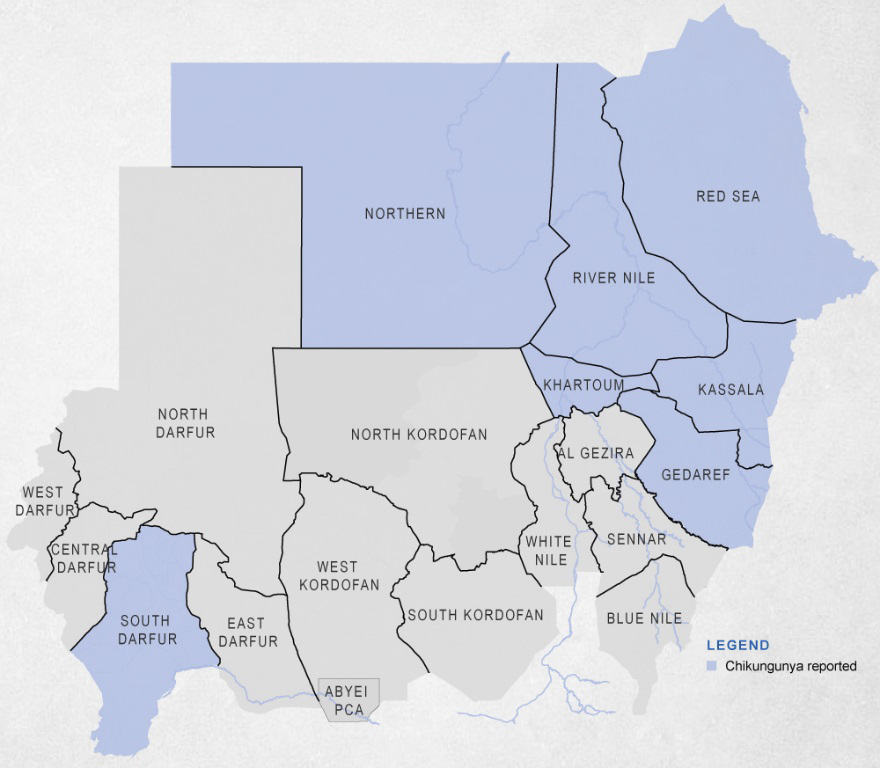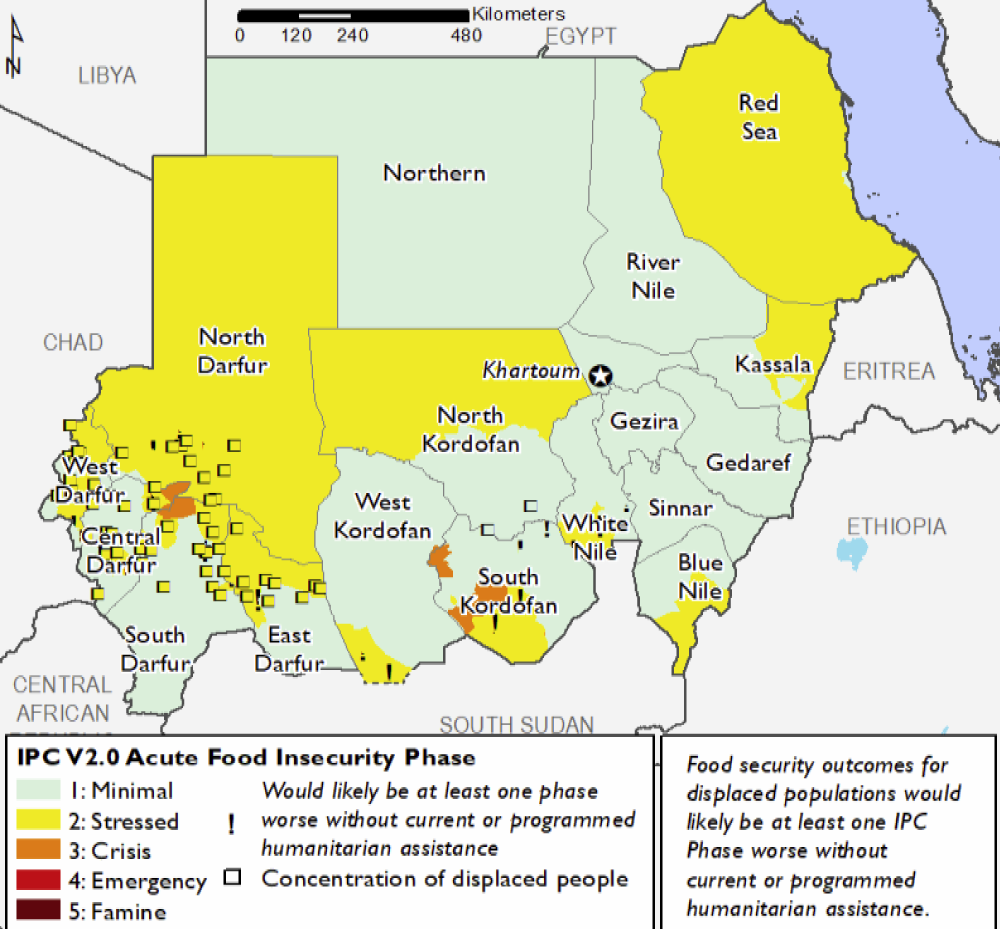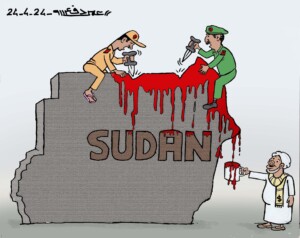Sudan OCHA bulletin 17: Over 19,000 cases of chikungunya reported across the country
In a recent update from the World Health Organization (WHO), seven states in Sudan, including Kassala, Red Sea, Al Gedaref, River Nile, Northern State, South Darfur, and Khartoum, have reported cases of chikungunya between 31 May and 2 October 2018.

In a recent update from the World Health Organization (WHO), seven states in Sudan, including Kassala, Red Sea, Al Gedaref, River Nile, Northern State, South Darfur, and Khartoum, have reported cases of chikungunya between 31 May and 2 October 2018.
According to the latest bulletin of the UN Office for the Coordination of Humanitarian Affairs (OCHA) in Sudan, a total of 19,224 cases of chikungunya have been reported, 95 per cent of which are from Kassala State. Approximately seven per cent of the reported cases are children less than 5 years of age and 60 per cent are females. No hospital admissions or deaths have been officially reported.
On 31 May 2018, the State Ministry of Health (SMoH) of Red Sea State reported four suspected cases of chikungunya fever from Swakin locality. On 8 August, the first suspected case of chikungunya was reported in neighbouring Kassala State, in a male travelling to the state from Red Sea. Since then cases have been reported in the three localities of Kassala, West Kassala and Rural Kassala.
On 10 August, blood samples were collected and were tested at the National Public Health Laboratory (NPHL) in Khartoum. Of the 24 samples collected, 22 tested positive for chikungunya. On 9 September, an additional 100 samples were collected; results showed that 50 per cent tested positive for mixed chikungunya and dengue viruses, and all pools tested positive for chikungunya.

MAP: Presence of Chikungunya in Sudan by state (Source: WHO)
Chikungunya is a viral disease transmitted to humans by infected mosquitoes. It causes fever and severe joint pain. Other symptoms include muscle pain, headache, nausea, fatigue and rash. There is no cure for chikungunya and treatment focuses on relieving symptoms. Most patients recover fully, but in some cases joint pain may persist for several months, or even years. Prevention and control relies heavily on eliminating mosquito breeding sites.
Joint Government-UN visit to Khartoum “open areas”
The Humanitarian Coordinator (HC) in Sudan, Gwi-Yeop Son, along with the Commissioner of the Commission for Refugees (CoR), Hamad Elgizouli Morowa, Director of the General Directorate for Organizations and Projects/Head of the Joint Procedures Centre, Dr. Mohamed Sennari, and the UN Refugee Agency (UNHCR) Representative in Sudan, Noriko Yoshida, jointly visited on 9 October South Sudanese refugee and host communities in Naivasha, Umbadah locality, which is the second largest “open area” refugee settlement in Khartoum State.
The CoR Commissioner reassured that the refugees are welcome in Sudan. “Until the time comes when you can return to South Sudan, we welcome you, and with our partners from the UN and other organizations we will continue to support you to the best of our abilities,” Mr. Morowa said.
The Director of the General Directorate for Organizations and Projects assured the South Sudanese refugees that Sudan will continue to support them until their plight is solved and asked the international community to give more attention to refugees in Sudan. The HC expressed her appreciation to the Government of Sudan for the long-standing generosity and support to refugees. The Government—with the support of UNHCR—has an ongoing campaign to register all South Sudanese refugees and is providing them with documents.
In August 2018, the Government of Sudan and humanitarian actors finalized the inter-agency Khartoum Open Areas Response Plan to address the most critical needs of an estimated 58,000 refugees in nine open areas in Khartoum State for an initial period of nine months. To date, only minimal interventions have been provided to the refugees in these “open areas”. The Office for the Coordination of Humanitarian Affairs (OCHA) managed Sudan Humanitarian Fund (SHF) has approved US$2 million to address the immediate needs of the refugees. This covers approximately 10 per cent of the $20 million total requirement for the response plan.
Between 2010 and 2013, UNHCR and the Commissioner for Voluntary Humanitarian Works (CVHW)—in collaboration with the International Organization for Migration (IOM)—assisted the voluntary return of some 75,000 South Sudanese people living in Sudan to South Sudan. In Khartoum State, the South Sudanese population willing to return were advised to assemble at 41 departure points (staging areas). However, in 2013, as conflict erupted in South Sudan, many of these South Sudanese people were left stranded and were unable or unwilling to return. As a result, the departure points in Khartoum have gradually evolved into so-called “open areas,” where South Sudanese refugees are now living in poor conditions.
Despite recent decline, prices of staple foods remain at record or near record highs – FPMA
In September, prices of locally-grown sorghum and millet declined for the first time in months as traders began to release stocks in anticipation of the 2018 harvest, reports UN Food and Agriculture Organization (FAO) in their latest Food Price Monitoring and Analysis (FPMA) Bulletin. Despite this decline, overall prices of grains in September 2018 were still two to three times higher compared to prices in September 2017. These high prices are a result of the depreciation of the local currency and the removal of wheat subsidies in the 2018 government budget, which triggered a demand for millet and sorghum as substitute foods, the report states. Shortages of foreign currency and fuel coupled with high-prices of agricultural inputs have increased the market prices of food commodities and raised concerns over the impact on the 2018 harvest.
Effect of economic conditions and fuel shortages on vulnerable people
According to various reports, all these factors (shortages of foreign currency and fuel and high-prices of agricultural inputs) will likely impact household purchasing power especially for vulnerable internally displaced persons (IDPs) and poor households. Household purchasing power will be well below average and assistance needs will be higher than in normal harvest periods. The economic conditions and fuel shortages also affect the provision of assistance. For example, in areas where water is trucked in, the increase in transportation costs could result in a decrease in amount of water provided to people in need if aid organizations are not able to secure more funds to cover increasing costs.
FEWS NET anticipates improved food security during the harvest period
Despite high staple food prices, FEWS NET projections through January 2019 anticipate that food security for the majority of households is likely to improve during the harvest period, according to their latest Sudan Food Security Outlook Update. This is mainly due to the availability of household food stocks and in-kind payments from agricultural labour as well as increased livestock productivity. The number of people facing Crisis – Integrated Food Security Phase Classification (IPC) Phase 3 – levels of food insecurity (when people are forced to forgo some food items and malnutrition levels start increase) will decrease during the harvest but will continue to remain atypically high due to the ongoing macroeconomic challenges. Accordingly, food security outcomes for most households in North Darfur and Kassala states will improve to Stressed (IPC Phase 2)— when even with humanitarian assistance some households are unable to meet some essential non-food expenditures—and Minimal (IPC Phase 1) levels—when households are able to meet essential food and non-food requirements. Food security outcomes for IDPs and poor households in areas controlled by the Sudan People’s Liberation Movement – North (SPLM-N) in areas of South Kordofan as well as for new IDPs in Jebel Marra in South and Central Darfur states, will face Crisis (IPC Phase 3) levels due to their limited access to cultivation, eroded livelihoods, and restricted movement, FEWS NET says.
Projected outlook through January 2019

Source: FEWS NET
Sudan calls on the SPLM-N to allow aid to reach vulnerable people in the Two Areas
The General Commissioner of government’s Humanitarian Aid Commission (HAC), Ahmed Mohamed Adam, on 27 September announced the Government of Sudan’s agreement to the delivery of humanitarian aid to vulnerable people in need of assistance in SPLM-N controlled areas of Blue Nile and South Kordofan states. The HAC commissioner called on the SPLM-N to accept the initiative so that vulnerable people—who have been unable to access assistance from within Sudan since 2011—can receive the help they need.
The United Nations Resident and Humanitarian Coordinator in Sudan, Ms. Gwi-Yeop Son, welcomed this decision and stated that the United Nations is ready to work closely with the Government of Sudan and with the leadership of the SPLM-N in Blue Nile and South Kordofan to coordinate more permanent and sustainable access.











 and then
and then